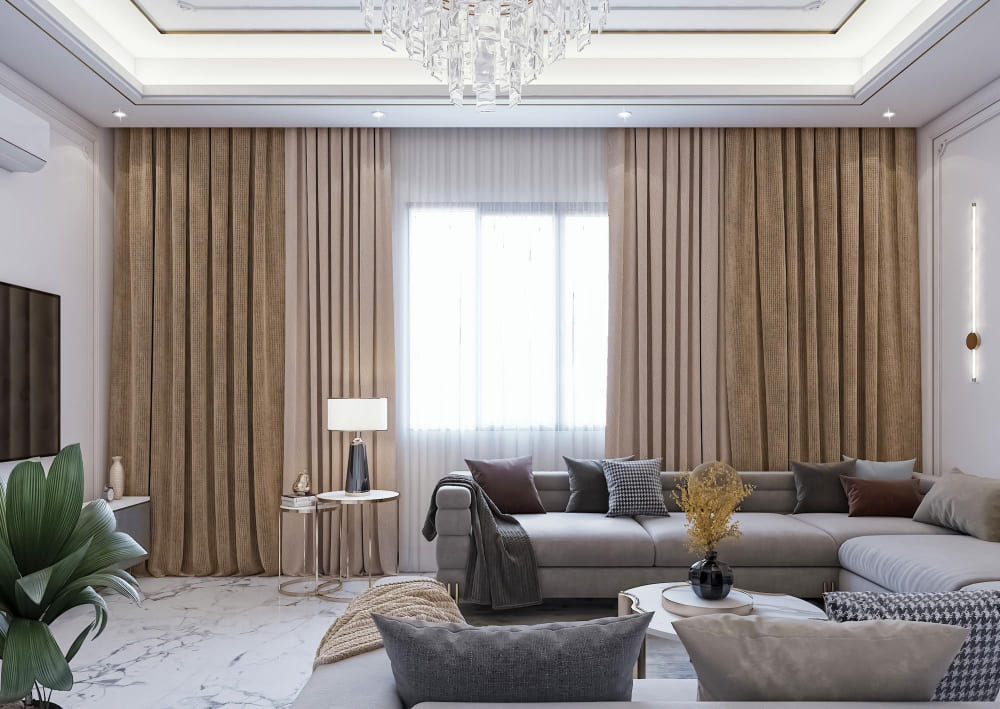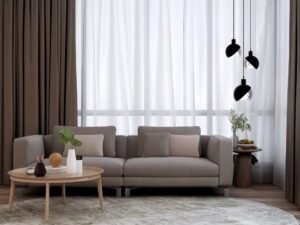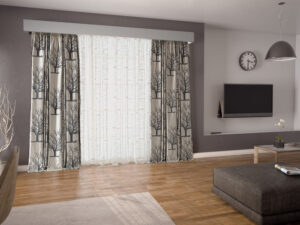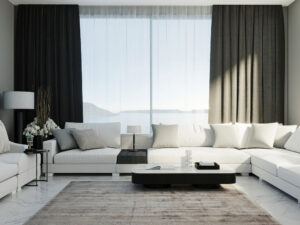CONTENTS

Elevate Your Space: Choosing the Perfect Living Room Curtains
The living room is the heart of your home, where you gather with family and friends to relax, entertain and create memories that last a lifetime. One of the key elements that can truly elevate your space and give it a new lease of life is curtains.
Ahead, we’ll guide you through some key considerations to help you find the perfect living room curtains that will complement your style, enhance your décor and add that finishing touch of elegance to your living room. Read on!
Unique Ways To Style Your Living Room Curtains
From bold patterns to unique textures, these living room curtain styling ideas will inspire you to take your curtains to the next level. Keep reading to learn more!
Go Monochromatic

Instead of choosing different colors or patterns for your curtains and blinds, you can opt for a monochromatic scheme to create a more polished and sophisticated look.
For example, if your living room has beige walls, you could choose curtains in a darker shade of beige or tan. This will enhance the texture and depth of your space without overwhelming it with too many colors or patterns.
Monochromatic curtains can also work well in smaller spaces, creating an illusion of height and spaciousness.
Create Contrast by Playing with Darks and Lights

Light and dark shades create depth and dimension in your living space, making it feel more dynamic and interesting. This technique involves pairing curtains in contrasting colors, such as black and white or navy and cream, to create a bold and eye-catching look.
For example, if you have light-colored walls and furniture, you could add drama by using dark curtains in charcoal or deep navy shades.
Alternatively, if your walls are dark, you could add contrast by using light-colored curtains in ivory or pale gray shades.
When layering curtains, you can also play with the opacity level to create different light and dark levels.
Sheer curtains paired with opaque ones can create a subtle contrast, while thicker curtains with contrasting patterns or textures can make a bolder statement.
Add Punch with Pattern

Bored with plain living room decor? Try adding a pattern element to your curtain. The beauty of adding patterns is that you can choose from various patterns—from floral prints to geometric shapes to abstract designs.
A popular trend in patterned curtains is mixing and matching different patterns in the same color palette, creating a dynamic and eclectic look.
For instance, if your living room has a neutral color scheme, you could choose curtains with a bold black-and-white geometric pattern to add a striking focal point to the room.
Conversely, if you want to create a softer look, you could choose curtains with a muted floral pattern in pastel pink or blue shades.
Whatever pattern you choose, make sure that it complements the overall style of your living room and enhances its décor.
Add Personality with Shibori

Shibori is a Japanese dyeing technique that involves folding, twisting, and binding fabric before dyeing it, creating unique and beautiful patterns.
There are various Shibori patterns and colors, including indigo blues, deep purples, and earthy browns. The beauty of this technique is that no two pieces are the same, so your Shibori curtains will be a one-of-a-kind addition to your living space.
When styling with Shibori, it’s important to make sure that the curtains complement your living room’s overall color scheme and décor.
For instance, if your living room has an eclectic style, you could opt for Shibori curtains with multiple colors or an abstract pattern to create a unique and eye-catching focal point.
Add Texture with Macramé

Want to get more creative? If you have some free time, try creating a macramé combination for your plain curtain to add flair.
Macramé is a knotting technique that involves creating patterns by tying knots in cords and strings.
You can incorporate macramé into your curtains in many ways, such as using macramé panels or adding macramé fringes to the bottom of your curtains.
For instance, you can use a lark’s head knot to create a simple and elegant design or a square knot to create a more complex pattern.
On the flip hand, you can add macramé fringes to the bottom of your curtains to create a playful and bohemian look.
To do this, simply tie on a series of macramé cords of varying lengths to the bottom of your curtain. This will add movement and texture to your curtains, creating a whimsical and inviting atmosphere.
How To Choose Curtains for a Living Room
Besides being creative, choosing curtains for a living room requires several important, calculated steps. Here’s a simple step-by-step to choose the perfect curtain for your living room area:
Length and Width

Choosing the perfect curtain is not just about finding a style that complements your decor—you want to ensure the curtains are the right size to create a polished, cohesive look.
To determine the proper length, measure from the top of the curtain rod to where you want the curtains to end.
Do you prefer a dramatic floor-to-ceiling look, or do you want the curtains just barely to brush the floor?
Remember that longer curtains can make a room feel grander, while shorter curtains can make a room feel more casual.
As for the width, consider the size of your windows and the amount of natural light you want to let in.
A general rule of thumb is to multiply the width of your window by 1.5-2 to get the ideal width for your curtains. This will ensure your window curtains are full enough to provide privacy and block out light when needed.
Use these measurements as a starting point, and let your intuition guide you as you choose the perfect curtains for your space.
Placement and Needs

Placement is important because it affects how the curtains will hang.
For example, if you plan to open and close your curtains frequently, you’ll want to ensure enough clearance between the curtains and adjacent furniture or walls. You don’t want the curtains to get caught on anything or leave scuff marks on your walls!
Additionally, consider where the curtains will fall in relation to your windows. Will they cover the entire window, or will they only partially cover it? This can affect how much light enters the room and your privacy.
As for needs, think about what you want your living room curtains to do for you beyond just looking beautiful.
Do you need them to block out light in a room with much sun exposure? Or perhaps you live in a noisy area and need curtains that absorb sound. Maybe you want your curtains to provide extra insulation during colder months.
There are curtains designed to meet specific needs, so look for ones that offer the desired features.
Fabric

The type of fabric you select is just as important as the length and width, as it greatly impacts the overall look and feel of the room.
Firstly, consider the weight of the fabric. Heavier fabrics, such as brocade or velvet, can provide a touch of luxury, but they may not be practical for everyday use. Lighter fabrics like linen or cotton can offer a casual, relaxed vibe and work well in more laid-back spaces.
Next, consider the texture of the fabric. Do you want something smooth and silky or rougher and more natural? The texture can add dimension and interest to your curtains and complement other textures in your decor.
Finally, think about the practical aspects of the fabric. Do you need curtains that are easy to clean, or are you willing to invest in dry cleaning? Does anyone in your household have allergies that certain fabrics may aggravate?
These factors may influence the type of fabric you ultimately choose.
Frequently Asked Questions
What kind of curtains are used in a living room?
Some popular types of living room curtains are drapes, sheer curtains, tab top curtains, grommet curtains, and valances. The choice depends on personal style and specific needs.
Should curtains match the sofa?
Curtains do not have to match the sofa, but they should complement each other and the room’s overall decor. It’s up to personal preference and desired aesthetic.
Should your curtains be lighter or darker than your walls?
As a general rule, curtains can be either lighter or darker than walls. Lighter curtains can help create a bright and airy feel in a room, while darker curtains can add contrast and drama. However, it’s always a good idea to consider the overall balance and harmony of the space when selecting curtain colors.
Conclusion
In conclusion, choosing the perfect living room curtains can elevate your space and create the look and feel you desire by considering factors such as style, function, and color. Remember, there are no hard and fast rules when selecting curtains, so don’t be afraid to get creative and experiment with different styles and colors until you find the perfect fit.
Whether you opt for luxurious drapes, breezy sheers, or something in between, the right living room curtains can create a beautiful, functional, and inviting living room. So go ahead, let your personal style shine through, and enjoy the process of transforming your home with the perfect curtains!

